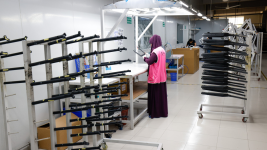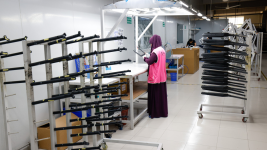- Copy to clipboard
- Thread starter
- #16
Saif
Senior Member
- Messages
- 14,516
- Reaction score
- 7,589
- Origin

- Residence

- Axis Group


বিà¦à¦«à¦à¦¿à¦à¦ à¦à¦° হালà¦à¦¾ পà§à¦°à¦à§à¦¶à¦² শিলà§à¦ª বিষà§à¦ পরামরà§à¦¶ সà¦à¦¾ à¦à¦¨à§à¦·à§à¦ িত
বাà¦à¦²à¦¾à¦¦à§à¦¶ বিনিà§à§à¦ à¦à¦¨à§à¦¨à§à¦¨ à¦à¦°à§à¦¤à§à¦ªà¦à§à¦·à§à¦° (বিডা) à¦à¦° à¦à¦¦à§à¦¯à§à¦à§, 'Potentials of the Light Engineering Industry/Sector in Bangladesh' শà§à¦°à§à¦·à¦ à¦à¦¬à§à¦·à¦£à¦¾ à¦à¦¾à¦°à§à¦¯à¦à§à¦°à¦®à¦à¦¿ বাà¦à¦²à¦¾à¦¦à§à¦¶ ফরà§à¦¨...
বিএফটিআই এর হালকা প্রকৌশল শিল্প বিষয়ক পরামর্শ সভা অনুষ্ঠিত
এফই অনলাইন ডেস্ক
Published :
May 14, 2024 17:50
Updated :
May 14, 2024 17:50

বাংলাদেশ বিনিয়োগ উন্নয়ন কর্তৃপক্ষের (বিডা) এর উদ্যোগে, 'Potentials of the Light Engineering Industry/Sector in Bangladesh' শীর্ষক গবেষণা কার্যক্রমটি বাংলাদেশ ফরেন ট্রেড ইনস্টিটিউট (বিএফটিআই)-পরিচালনা করছে।
এর অংশ হিসেবে ১৪ মে, ২০২৪ তারিখে বিএফটিআই এর সম্মেলন কক্ষে একটি অংশীজন পরামর্শ সভা অনুষ্ঠিত হয়েছে।
এই সভায় প্রধান অতিথি হিসেবে উপস্থিত ছিলেন বিএফটিআই এর প্রধান নির্বাহী কর্মকর্তা ও বাণিজ্য মন্ত্রণালয়ের সাবেক সিনিয়র সচিব ড. মোঃ জাফর উদ্দীন।
সভায় বিশেষ অতিথি হিসেবে উপস্থিত ছিলেন বাংলাদেশ বিনিয়োগ উন্নয়ন কর্তৃপক্ষের (বিডা) এর পরিচালক (যুগ্ম সচিব) জনাব এম মিজানুর রহমান।
অনুষ্ঠানে সভাপতিত্ব করেন বিএফটিআই এর পরিচালক মোঃ ওবায়েদুল আজম। বিএফটিআই এর এক প্রেস বিজ্ঞপ্তি থেকে এ তথ্য জানা যায়।
প্রধান অতিথি ড. মোঃ জাফর উদ্দীন বলেন, "লাইট ইঞ্জিনিয়ারিং একটি সম্ভাবনাময় শিল্প। এই খাতের উন্নয়নের জন্য সরকার নানাবিধ পদক্ষেপ গ্রহণ করেছে এবং সরকারের সকল মন্ত্রণালয় ও সংস্থা একযোগে কাজ করছে। বাংলাদেশ বিনিয়োগ উন্নয়ন কর্তৃপক্ষের (বিডা) উদ্যোগে এই গবেষণাটি বিএফটিআই কর্তৃক পরিচালনা করতে পারায় আমরা আনন্দিত।"
বিশেষ অতিথি বাংলাদেশ বিনিয়োগ উন্নয়ন কর্তৃপক্ষের (বিডা) এর পরিচালক (যুগ্ম সচিব) জনাব এম মিজানুর রহমান বলেন, "লাইট ইঞ্জিনিয়ারিং শিল্পের পরিধি অনেক বড়। সরকার লাইট ইঞ্জিনিয়ারিং শিল্পকে গুরুত্ব দিচ্ছে। এ শিল্পে বিনিযোগ আকর্ষণের ব্যাপক সম্ভাবনা রয়েছে।"
এছাড়াও সভায় উপস্থিত বাংলাদেশ ইঞ্জিনিয়ারিং ইন্ডাস্ট্রি ওনার্স এসোসিয়েশন এর সভাপতি জনাব আবদুর রাজ্জাক সহ পাবলিক ও প্রাইভেট সেক্টরের প্রতিনিধিবৃন্দ তাদের মূল্যবান মতামত প্রদান করেন।
এফই অনলাইন ডেস্ক
Published :
May 14, 2024 17:50
Updated :
May 14, 2024 17:50
বাংলাদেশ বিনিয়োগ উন্নয়ন কর্তৃপক্ষের (বিডা) এর উদ্যোগে, 'Potentials of the Light Engineering Industry/Sector in Bangladesh' শীর্ষক গবেষণা কার্যক্রমটি বাংলাদেশ ফরেন ট্রেড ইনস্টিটিউট (বিএফটিআই)-পরিচালনা করছে।
এর অংশ হিসেবে ১৪ মে, ২০২৪ তারিখে বিএফটিআই এর সম্মেলন কক্ষে একটি অংশীজন পরামর্শ সভা অনুষ্ঠিত হয়েছে।
এই সভায় প্রধান অতিথি হিসেবে উপস্থিত ছিলেন বিএফটিআই এর প্রধান নির্বাহী কর্মকর্তা ও বাণিজ্য মন্ত্রণালয়ের সাবেক সিনিয়র সচিব ড. মোঃ জাফর উদ্দীন।
সভায় বিশেষ অতিথি হিসেবে উপস্থিত ছিলেন বাংলাদেশ বিনিয়োগ উন্নয়ন কর্তৃপক্ষের (বিডা) এর পরিচালক (যুগ্ম সচিব) জনাব এম মিজানুর রহমান।
অনুষ্ঠানে সভাপতিত্ব করেন বিএফটিআই এর পরিচালক মোঃ ওবায়েদুল আজম। বিএফটিআই এর এক প্রেস বিজ্ঞপ্তি থেকে এ তথ্য জানা যায়।
প্রধান অতিথি ড. মোঃ জাফর উদ্দীন বলেন, "লাইট ইঞ্জিনিয়ারিং একটি সম্ভাবনাময় শিল্প। এই খাতের উন্নয়নের জন্য সরকার নানাবিধ পদক্ষেপ গ্রহণ করেছে এবং সরকারের সকল মন্ত্রণালয় ও সংস্থা একযোগে কাজ করছে। বাংলাদেশ বিনিয়োগ উন্নয়ন কর্তৃপক্ষের (বিডা) উদ্যোগে এই গবেষণাটি বিএফটিআই কর্তৃক পরিচালনা করতে পারায় আমরা আনন্দিত।"
বিশেষ অতিথি বাংলাদেশ বিনিয়োগ উন্নয়ন কর্তৃপক্ষের (বিডা) এর পরিচালক (যুগ্ম সচিব) জনাব এম মিজানুর রহমান বলেন, "লাইট ইঞ্জিনিয়ারিং শিল্পের পরিধি অনেক বড়। সরকার লাইট ইঞ্জিনিয়ারিং শিল্পকে গুরুত্ব দিচ্ছে। এ শিল্পে বিনিযোগ আকর্ষণের ব্যাপক সম্ভাবনা রয়েছে।"
এছাড়াও সভায় উপস্থিত বাংলাদেশ ইঞ্জিনিয়ারিং ইন্ডাস্ট্রি ওনার্স এসোসিয়েশন এর সভাপতি জনাব আবদুর রাজ্জাক সহ পাবলিক ও প্রাইভেট সেক্টরের প্রতিনিধিবৃন্দ তাদের মূল্যবান মতামত প্রদান করেন।













